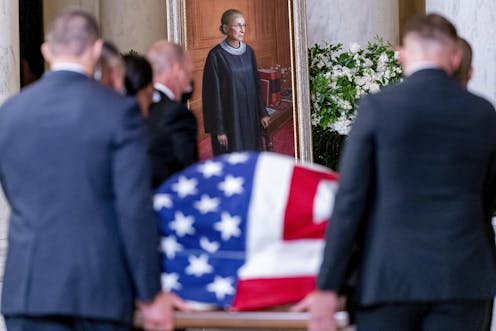In death, as in life, Ruth Bader Ginsburg balanced being American and Jewish
- Written by Jonathan D. Sarna, University Professor and Joseph H. & Belle R. Braun Professor of American Jewish History, Brandeis University

As news of the passing of Justice Ruth Bader Ginsburg spread on the eve of Rosh Hashana, the Jewish New Year, a common question heard in discussions among American Jews was: “When will she be buried[1]?”
As a longtime scholar of American Jewish life[2], I understood that the question behind that question was whether, in death, Justice Ginsburg’s family would comply with longstanding Jewish tradition that mandates prompt burial[3]. Or, in accordance with longstanding American tradition[4], would her burial be delayed so that mourners might pay her respects?
In death, as in life, American Jews looked to see how Justice Ginsburg balanced being an American and being a Jew.
‘Dust returns to the earth’
“Jewish custom insists on prompt burial…a consideration of particular relevance in hot climates,” the authoritative Encyclopaedia Judaica explains[5]. To honor the dead, Orthodox Jews perform burials as quickly as possible, sometimes within just a few hours.
That’s not always possible, of course. Funerals can be delayed when the death falls on the Sabbath – a day of rest in the Jewish faith when no burials are performed – or on a Jewish holiday. They can also be delayed to accommodate the needs and considerations of close relatives traveling in from afar.
The practice of burying Jews swiftly is so deeply ingrained, however, that in 1995 Israeli Prime Minister Yitzhak Rabin, who was far from Orthodox and whose funeral was attended by leaders who rushed in from around the world[6], had his funeral performed and was buried within just two days of his assassination.
If Justice Ginsburg’s family did not follow Jewish tradition by delaying her burial, in other respects they honored that tradition to the hilt. For example, the wooden casket lying in repose[7] at the Supreme Court and in state at the Capitol remained firmly shut. And in keeping with Jewish practice, there was no public viewing of her body and, apparently, no embalming. Far from preserving the body, Jews believe, following the book of Ecclesiastes in the Hebrew Bible, that “the dust returns to the earth as it was[8]” –- the sooner the better.
A fitting rest
Justice Ginsburg also received, for the first time in American Jewish history, a traditional Jewish funeral in the Great Hall of the Supreme Court[9]. Rabbi Lauren Holtzblatt[10], a Conservative rabbi of Congregation Adas Israel in Washington and a friend of Ginsburg’s whose husband once served as the justice’s law clerk, presided alongside Chief Justice John Roberts.
The service included all the familiar components of a Jewish funeral including a stirring eulogy, recitation of the 23rd Psalm[11], and the chanting, in Hebrew, of the late medieval prayer El Maleh Rachamim[12]: “God full of mercy…grant fitting rest.” The prayer recited at Ginsburg’s funeral included the justice’s full Hebrew name – Yita Ruchel bat Celia – which includes her mother’s name, but untraditionally, not her father’s.
Usually, burial in a Jewish cemetery follows immediately upon a Jewish funeral, individual mourners reverently accompanying the casket to wherever the cemetery is located. There, around the open grave, additional prayers including a special kaddish, a praise of God, are recited and the casket is lowered.
Mourners and community members then personally participate in the powerful act of filling the grave in, shoveling a spadeful of dirt atop the casket, each thump reinforcing the finality that death represents.
[Deep knowledge, daily. Sign up for The Conversation’s newsletter[13].]
In the case of Justice Ginsburg, that won’t happen in a Jewish cemetery. Instead, after her casket lies in state, it will be transported to Arlington National Cemetery[14] for a private burial service. Arlington, a national and non-denominational cemetery, has no special section set aside for Jews and explicitly forbids some traditional Jewish rituals such as manually lowering the casket and filling in the grave[15].
Two identities
The traditional Jewish elements in Justice Ginsburg’s funeral and the departures from Jewish tradition connected with her burial both reflect aspects of her identity. She took great pride in her Jewish heritage[16] but broke with most traditional Jewish practices.
In death, as in life, she cherished two identities – being an American and being a Jew – even when they failed to easily harmonize. Her Jewish funeral and Arlington National Cemetery burial speak to her quest to balance these two identities.
References
- ^ When will she be buried (forward.com)
- ^ scholar of American Jewish life (www.brandeis.edu)
- ^ mandates prompt burial (www.jewish-funeral-guide.com)
- ^ longstanding American tradition (theconversation.com)
- ^ Encyclopaedia Judaica explains (www.jewishvirtuallibrary.org)
- ^ attended by leaders who rushed in from around the world (www.baltimoresun.com)
- ^ lying in repose (www.npr.org)
- ^ the dust returns to the earth as it was (biblehub.com)
- ^ Jewish funeral in the Great Hall of the Supreme Court (www.washingtonpost.com)
- ^ Rabbi Lauren Holtzblatt (www.adasisrael.org)
- ^ 23rd Psalm (www.mechon-mamre.org)
- ^ El Maleh Rachamim (www.myjewishlearning.com)
- ^ Sign up for The Conversation’s newsletter (theconversation.com)
- ^ transported to Arlington National Cemetery (www.stripes.com)
- ^ manually lowering the casket and filling in the grave (dc.jewish-funerals.org)
- ^ great pride in her Jewish heritage (www.jpost.com)
Authors: Jonathan D. Sarna, University Professor and Joseph H. & Belle R. Braun Professor of American Jewish History, Brandeis University

